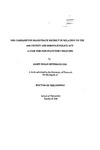Carhampton magistrate district in relation to the 1856 County and Borough Police Act : a case for non-statutory policing
| dc.contributor.author | Setterington, Janet Susan | |
| dc.contributor.other | Faculty of Arts, Humanities and Business | en_US |
| dc.date.accessioned | 2011-05-12T11:56:20Z | |
| dc.date.available | 2011-05-12T11:56:20Z | |
| dc.date.issued | 2005 | |
| dc.identifier | Not available | en_US |
| dc.identifier.uri | http://hdl.handle.net/10026.1/425 | |
| dc.description.abstract |
The 1856 County and Borough Police Act had a pronounced effect on the criminal statistics in Somerset. Assize and Quarter Session committal statistics dropped across the county as a whole and this fall was reflected in six of seven individual magistrate areas studied. The seventh, the Carhampton magistrate district, showed no reduction in recorded crime. The records, in fact, suggest that the area was either subject to little criminal activity, or that people were not reporting offences. The lack of petty session records in Somerset prevented their inclusion in this study. In this thesis a number of criteria are applied to the recorded crime rate, including geological and geographical input, weather conditions, crop surplus and shortages, industry, cost of living, employment, wages, poor relief and instances of stability within individual districts. The Carhampton magistrate district had the advantage of stability in population levels and a long serving constable. There was also a continuity in parish officers. The paternalistic, major landowner used a degree of coercion in controlling his tenants and employees. However, in somei nstancesth e districtw as distinctly disadvantaged,p articularly in terms of the isolationo f smalls ettlementsa, contractinge conomicb asea nd a lack of communication networks to the outside world. Two major factors appear to have influenced recorded crime in the district. One stemmedfr om the controlling attitude of the major landownersa nd the other from the social cohesion of the mainly labouring communities living within small and isolated settlements. Theoretical and model evidence suggests that communities in this district accepted social responsibilitya nd self regulation in relation to crime accordingt o local perceptionso f wrong doing. This thesis does not suggest that the Carhampton magistrate district was devoid of crime but rather that its isolation resulted in the approach to crime being dictated by the social structure of the area. It is not claimed that this district is unique, but that the findings here might be applied to other isolated areas both historically and contemporarily. | en_US |
| dc.language.iso | en | en_US |
| dc.publisher | University of Plymouth | en_US |
| dc.title | Carhampton magistrate district in relation to the 1856 County and Borough Police Act : a case for non-statutory policing | en_US |
| dc.type | Thesis | |
| dc.identifier.doi | http://dx.doi.org/10.24382/3695 |
Files in this item
This item appears in the following Collection(s)
-
01 Research Theses Main Collection
Research Theses Main


